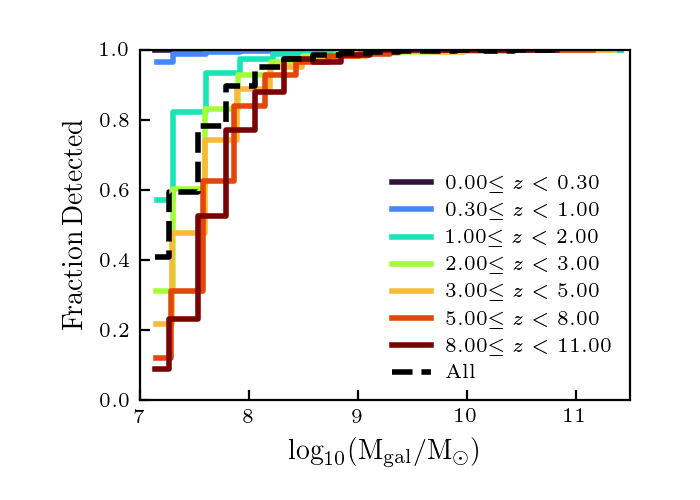Nicole Drakos
Research Blog
Welcome to my Research Blog.
This is mostly meant to document what I am working on for myself, and to communicate with my colleagues. It is likely filled with errors!
This project is maintained by ndrakos
Generating Galaxies Analytically
There is a problem reproducing observed LFs, as discussed in this post. I concluded that this discrepancy is likely because we have a low resolution in \(512^3\) simulations which is incomplete below galaxy masses of \(\sim 10^9 M_{\odot}\).
Since analyzing the simulations will take a while, I am going to check this from a mock catalog where galaxy redshifts are determined analytically by sampling from the redshift distribution. Since these results aren’t based on a simulation, we don’t have halo information or exact positions (which is needed to measure the 2PCF), but we can still obtain redshifts, galaxy masses and SEDs.
Methods
-
Redshifts - To generate redshifts, I selected \(10^6\) galaxies from the redshift distribution, as outlined in this post when creating the random catalog for the 2PCF calculation.
-
Masses - The masses were drawn from the SMFs, as in abundance matching, but without the need to rank order. The minimum mass will be \(10^7\).
-
SEDs - The SED assignment only depends on galaxy masses and redshifts, so this can be run the same as before.
Results
Note: there should actually be \(\approx 3 \times 10^6\) galaxies above \(10^7 M_{\odot}\). Therefore, number counts should increase by a factor of 3, and the standard deviation in the galaxy counts should scale as \(1/\sqrt{3}\).
Detections
We can now have predictions for the completeness of the sample down to masses of \(10^7\):

This completeness measurement can be used to correct things like the LFs.
UV properties
This is how including the low mass galaxies affects the UV properties:

For comparision, see the same plot here.
There is an improvement on the faint end of the \(\beta\)–\(M_{\rm UV}\) relation, but there are still descrepancies for bright objects. My best guess is it is because the age distribution I am sampling from is not realistic.
Luminosity Functions
First, I realized Bouwens 2015 is only applicable for redshifts above 4, which is not approriate for all the comparisons. For now, I am using Arnouts et al. 2005 for \(z<1\), Oesch et al. 2010 for \(1\leq z<3\) and Bouwens et al. 2015 for \(z \ge 3\)
As before, I am sampling the UV magnitude from the W18 relations, rather than use those measured from our SEDs.

This looks a lot better than before, but there are still some descrepancies with observations. They look complete above a magnitude of \(\sim -18\) at this mass resolution (is this enough for our purposes, or will we have to add in low mass halos to the simulations? Note that less than 10 percent of the \(10^7\) galaxies are detected in the high mass bin).